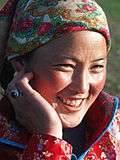
Daur people
The Daur people (Khalkha Mongolian: Дагуур/Daguur; simplified Chinese: 达斡尔族; traditional Chinese: 達斡爾族; pinyin: Dáwò'ěr zú; the former name "Dahur" is considered derogatory) are a Mongolic-speaking ethnic group. They form one of the 56 ethnic groups officially recognized in the People's Republic of China. They numbered 131,992 according to the latest census (2010), and most of them live in the Morin Dawa Daur Autonomous Banner (Mòlì Dáwǎ Dáwò'ěrzú Zìzhìqí 莫力達瓦達斡爾族自治旗/莫力达瓦达斡尔族自治旗) in Hulun Buir, Inner Mongolia autonomous region of China. There are also some near Tacheng in Xinjiang, where their ancestors were moved during the Qing Dynasty. Daguur in Mongolian language means "follower/copier" as in dagakh "to follow/copy" (also cf. Manchu daha- "to follow; to submit, to surrender; to obey; to accord, to be because, to be since").
Language
Daur is a Mongolic language. There is no written standard, although a Pinyin-based orthography has been devised by the native Daur scholar Merden Enhebatu. The Daur language retains some Khitan substratal features, including a number of lexemes not found in other Mongolic languages. It is made up of three dialects: Bataxan, Hailar, Qiqihar.
Podcasts:

